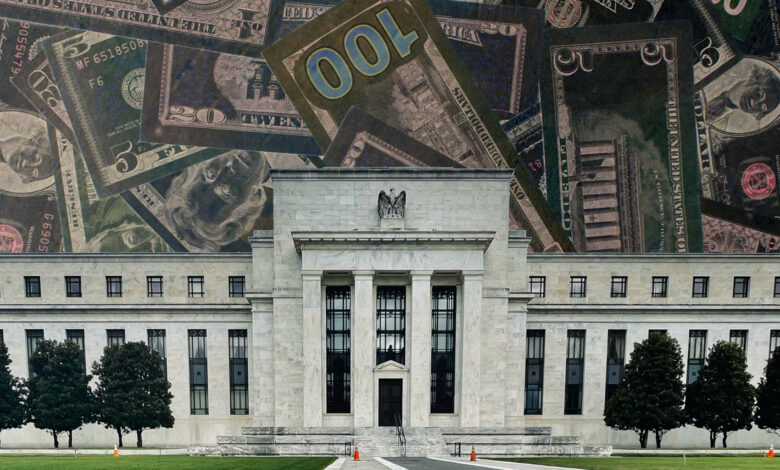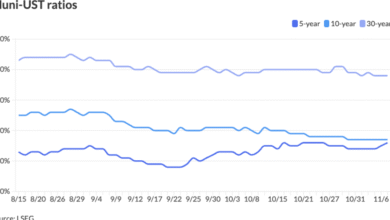The narrative of Fed rate cuts shifts! Market scales back December rate cut bets; the ‘global asset pricing anchor’ reestablishes above 4%.

The 10-year U.S. Treasury yield closed above 4% this week, primarily as traders significantly scaled back their bets on interest rate cuts.
U.S. Treasury yields unexpectedly rose this week as bond traders drastically reduced their expectations for rate cuts. This followed hawkish signals from Federal Reserve Chair Jerome Powell after the Fed’s latest rate cut and robust economic data indicating continued resilience in the overall U.S. macroeconomy. Traders sharply moderated their near-certain December rate-cut expectations, while also lowering their projections for cuts in 2026.
Known as the ‘global asset pricing anchor,’ $U.S. 10-Year Treasury Notes Yield (US10Y.BD)$ the yield once again stabilized above 4%, closing at 4.09% on Friday after being notably below 4% earlier in the week. This movement reflects a sudden shift in market sentiment: interest rate swap contracts tied to the Fed’s December meeting now imply an approximately 50-50 chance of a rate cut in December, down from over 90% before Powell’s hawkish remarks.
Although Federal Reserve monetary policymakers announced another 25-basis-point rate cut early Thursday morning Beijing time—marking two consecutive 25-basis-point cuts this year—Powell stated that further monetary easing at the final meeting of the year was “far from a done deal,” triggering a broad sell-off in the bond market.

This year, U.S. Treasury investors have faced mounting pressure due to inflation concerns stemming from the global trade war initiated by the Trump administration, coupled with an increasingly expansive debt outlook from the U.S. Treasury Department.
Particularly, amid expectations of a significant expansion in the U.S. government budget deficit and growing pessimism about Treasury yields, bond traders have begun demanding higher “term premiums.” As a result, the 10-year U.S. Treasury yield has consistently hovered around 4%, or even above 4.5%, putting substantial downward pressure on the valuation of risk assets such as equities. If the 10-year U.S. Treasury yield remains below 4% and continues on a downward trajectory, it would undoubtedly provide strong support for a continued bull market in global equities, particularly benefiting tech stocks closely tied to artificial intelligence.
Global capital focuses on ‘the anchor of global asset pricing.’
Gregory Faranello, Head of U.S. Rates Trading and Strategy at AmeriVet Securities, noted that some of the “froth” in rate-cut expectations has dissipated, emphasizing that the current trend in U.S. Treasury price movements represents a relatively rational adjustment (U.S. Treasury yields and prices move inversely). “The story of lower U.S. rates hinges on a significant economic slowdown,” he said.
Investors had originally bet that the Federal Reserve would almost certainly continue to lower borrowing costs to support the recently persistently weak labor market, despite inflation remaining above the Fed’s anchored 2% target. However, it is worth noting that while a consensus has formed in the market that the U.S. economy and the non-farm labor market have shifted to a lower growth phase, neither the U.S. economy nor non-farm data has entered a stage of sustained negative growth indicative of stagnation.
Whether from ADP or Revelio employment statistics, both show that U.S. corporate hiring activity has significantly slowed compared to the peak periods of a hot job market, but still exhibits resilient modest growth. Moreover, both these statistical agencies and Wall Street giants like Goldman Sachs continue to anticipate a ‘Goldilocks soft landing’ for the U.S. economy.
Scheid, President of the Kansas City Fed and a long-time hawkish FOMC voter who cast a dissenting vote at this week’s Fed FOMC monetary policy meeting, stated on Friday that although the U.S. labor market has slowed, it remains fundamentally balanced; economic growth momentum persists, but inflation remains too high, making ‘keeping the policy rate unchanged at this week’s meeting an appropriate move.’
Moreover, for traders, there is a complete absence of economic data countering the hawkish stance of Federal Reserve officials. The ongoing U.S. government shutdown has halted the release of key economic data, drastically reducing the official signals traders can rely on, thereby making every statement by Powell even more closely watched.
This week, Meta Platforms,$Meta Platforms (META.US)$ the parent company of Facebook, issued up to $30 billion in bonds, demonstrating that U.S. tech giants’ AI-related expenditures remain robust and the market is beginning to recognize that these substantial AI investments can lead to stronger revenue generation — a point underscored by Google’s increasingly powerful AI cloud computing business; meanwhile, as investors absorb the new bond supply, downward pressure on U.S. Treasury prices is inevitable, prompting investors to sell Treasuries, which in turn pushes up long-term yields on U.S. government debt.$Microsoft (MSFT.US)$More corporate bond deals are expected next week.
“Despite hawkish remarks by Federal Reserve Chair Jerome Powell and other officials on Wednesday, the probability of a rate cut in December remains evenly split, which to some extent sustains demand for shorter-dated Treasuries; meanwhile, growing concerns about inflation have pushed yields higher at the long end of the curve (i.e., 10-year and longer Treasuries). More importantly, the upcoming debt issuance schedule will likely steepen the Treasury yield curve further, as back-end issuance of 10- and 30-year Treasuries will increase starting from the second week of November,” said Alyce Andres, macro strategist at Bloomberg Strategists.
Faranello from AmeriVet Securities noted that once month-end settlements pass, the 10-year Treasury yield may still face ‘some pressure.’ He pointed out that the recent highs of the 10-year Treasury yield could hover between 4.20% and 4.25%.
From a theoretical perspective, the 10-year Treasury yield corresponds to the risk-free interest rate indicator r in the denominator of the DCF valuation model, a crucial framework in equity markets. When other variables (particularly cash flow expectations in the numerator) remain relatively unchanged — such as during earnings season when the numerator lacks positive catalysts and enters a vacuum period — higher or sustained historically elevated levels of the denominator tend to exert downward pressure on valuations. This particularly affects high-valuation assets closely tied to AI, including technology stocks, high-yield corporate bonds, and cryptocurrencies, which may face a risk of valuation collapse.
It is precisely at$NVIDIA (NVDA.US)$, Meta, Google,$Oracle (ORCL.US)$、$Taiwan Semiconductor (TSM.US)$as well as$Broadcom (AVGO.US)$Driven by the historic stock price rallies of major tech giants and leaders in the AI computing power supply chain, along with consistently robust performance year-to-date, an unprecedented wave of AI-related investments has swept through the U.S. stock market and global equity markets, driving$S&P 500 Index (.SPX.US)$and the global benchmark index, the MSCI World Index, to surge significantly since April, recently hitting new all-time highs continuously.
Hawkish Fed officials firmly defend their stance against rate cuts.
Adding to the rebalancing that has reduced the probability of a December rate cut to a ‘fifty-fifty’ scenario, Lorie Logan, President of the Dallas Fed and 2026 FOMC voter, stated in prepared remarks on Friday that she ‘did not see a need for a rate cut this week.’ She further noted, ‘Unless there is clear evidence that inflation will recede faster than expected or that the labor market will cool more quickly, I would find it difficult to support another rate cut in December.’
Meanwhile, Jeff Schmid, President of the Kansas City Fed and a 2024 FOMC voter, outlined his key reasons for opposing a rate cut. Beth Hammack, President of the Cleveland Fed and a 2026 FOMC voter, also expressed disagreement with the decision to continue cutting rates this week, stating that the current interest rate is ‘almost neutral.’ If further cuts are made, the Federal Reserve could lose its policy tightening ability, which would be detrimental to bringing inflation back down to the 2% target.
These strongly hawkish statements from Fed officials have undoubtedly highlighted the ongoing divergence among policymakers regarding when to ease monetary policy. In contrast, Governor Christopher Waller, who holds a permanent voting position on the FOMC, has fully aligned himself with a dovish stance favoring rate cuts. He emphasized that the Fed should continue to opt for rate reductions at its next meeting in December, asserting that further cuts are ‘the right course of action.’
Notably, Waller was appointed as a Fed governor by Trump in 2020 and is also one of the five candidates under consideration by the Trump administration for the role of Fed Chair. Jerome Powell’s term as Fed Chair is set to expire in May 2026.
“What surprises me, and aligns with most other investors, is that whether to cut rates again in December remains a highly debated topic within the Fed,” said Jim Caron, Chief Investment Officer of Morgan Stanley’s Portfolio Solutions business. “However, I believe the issue is not about the trajectory of the Fed’s rate cuts but rather about the pace of those cuts.”
Editor/Rocky






